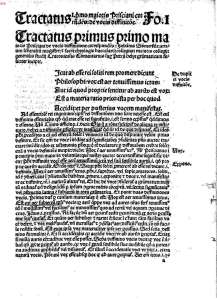The issues surrounding digitization are familiar in the realm of cultural semiotics, which provides some insight into the promise and dangers of digitization. These issues are partially explored by Baetens and Van Looy in an article entitled Digitizing Cultural Heritage: The Role of Interpretation in Cultural Preservation. Their idea is adapted from Lotman, Uspensky, and Mihaychuk’s concept of the Semiotic Mechanism of Culture, and provides an insight into the meaning and purpose of the digitized absolute archive. They discuss the concept of philological readings and hermeneutic readings, which respectively refer to the substance of the artifact (i.e. Lotman’s ‘text’) or the mechanism to place the artifact in cultural context (i.e. Lotman’s ‘code’). Separating these two components is crucial to their argument about digitization and memory, but it also clarifies the distinction between libraries and exhibitions.
Since I’ve been working on this blog, I’ve been stridently avoiding digitizing objects: my pictures have my hands in them, they are taken from odd angles, or in imperfect lighting situations. I leave, and sometimes encourage these blemishes, to emphasise that these are simply digital photos of the thing which I am be talking about, not a digital surrogate of the object. The goal is to explicate and explore, rather than attempt to compete with digitization efforts. This parallels the distinction of the text and the code.
Consider this image of a leaf from Helias Peterus Grammatica (BSB, P-372, right) taken from the systematic digitization efforts of the Bayerischen Staatsbibliothek. It is a flat point-of-view  mimicking the page, has a mechanism for determining scale, and is based on specific digitization standards and a systematic approach, leaving the text clear and philologically decipherable. Compare this with an image of the Apollodori Atheniensis Bibliotheces (CU Special Collections, BL780.A6 1555, left) that highlights a component of its binding. A hand is clearly visible, as is the manuscript
mimicking the page, has a mechanism for determining scale, and is based on specific digitization standards and a systematic approach, leaving the text clear and philologically decipherable. Compare this with an image of the Apollodori Atheniensis Bibliotheces (CU Special Collections, BL780.A6 1555, left) that highlights a component of its binding. A hand is clearly visible, as is the manuscript  used in reinforce the spine, but the image has no mechanism for determining scale, and is not based on any specific digitization standards. Its purpose is interpretive, or as Baetens and Van Looy call it, hermeneutic. It is intended to explore the code of the object, rather than its text. One would be overzealous to claim that the picture on the left is a meaningful digitization of the book, but it is quite effective in addressing the physicality of the artifact and the cultural code that it represents. Each image his different functions and goals.
used in reinforce the spine, but the image has no mechanism for determining scale, and is not based on any specific digitization standards. Its purpose is interpretive, or as Baetens and Van Looy call it, hermeneutic. It is intended to explore the code of the object, rather than its text. One would be overzealous to claim that the picture on the left is a meaningful digitization of the book, but it is quite effective in addressing the physicality of the artifact and the cultural code that it represents. Each image his different functions and goals.
This is the key difference between digital libraries, and digital exhibits. A digital library has some sort of systematic approach focused primarily on preserving the text of the artifacts represented, but expects the researcher to arrive with an understanding of the code already and makes no attempt to make it clear. The digital exhibit, on the other hand, servers to preserve the code of cultural interpretation for the objects, and may be less concerned with the text. This library-exhibit, or text-code, dichotomy characterizes one of the distinctions crucial in special collections libraries.
The special collection generally houses the physical artifact of record. This artifact of record is the form that, for some reason not necessarily related to value or rarity, has been selected to be preserved by the institution. The preservation of a specific form is a commitment to the code which might be contained and beyond current recording capabilities. Creating digital surrogates, or other facsimiles, may serve to preserve the text (and in some cases part of the code) but by retaining the actual object enables the hermeneutic analysis of the code. Properly, the digital exhibit is a manifestation of a pedagogical tool for describing code. This is ultimately the key difference.
Where the digital library, like a normal library, requires a systematic and standards based approach, the digital exhibit flourishes with a promiscuous and interpretive approach. I think this distinction is crucial as we move towards more specialized technology, because if we expect a library to be an exhibit, or vice-versa, we will ultimately be disappointed. Exhibit constructors and library constructors must keep in mind this crucial difference so that they can clearly satisfy their particular goals.